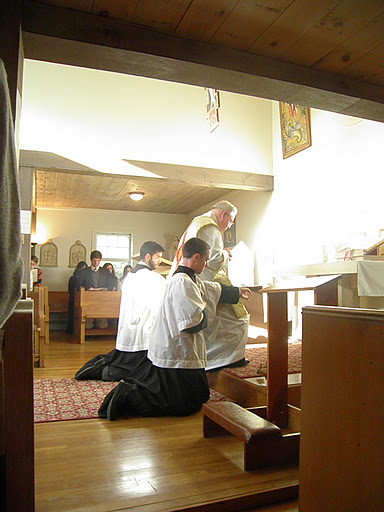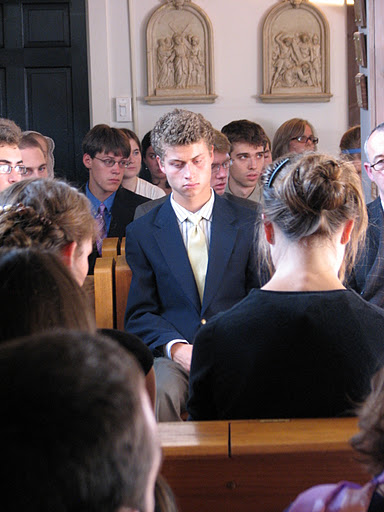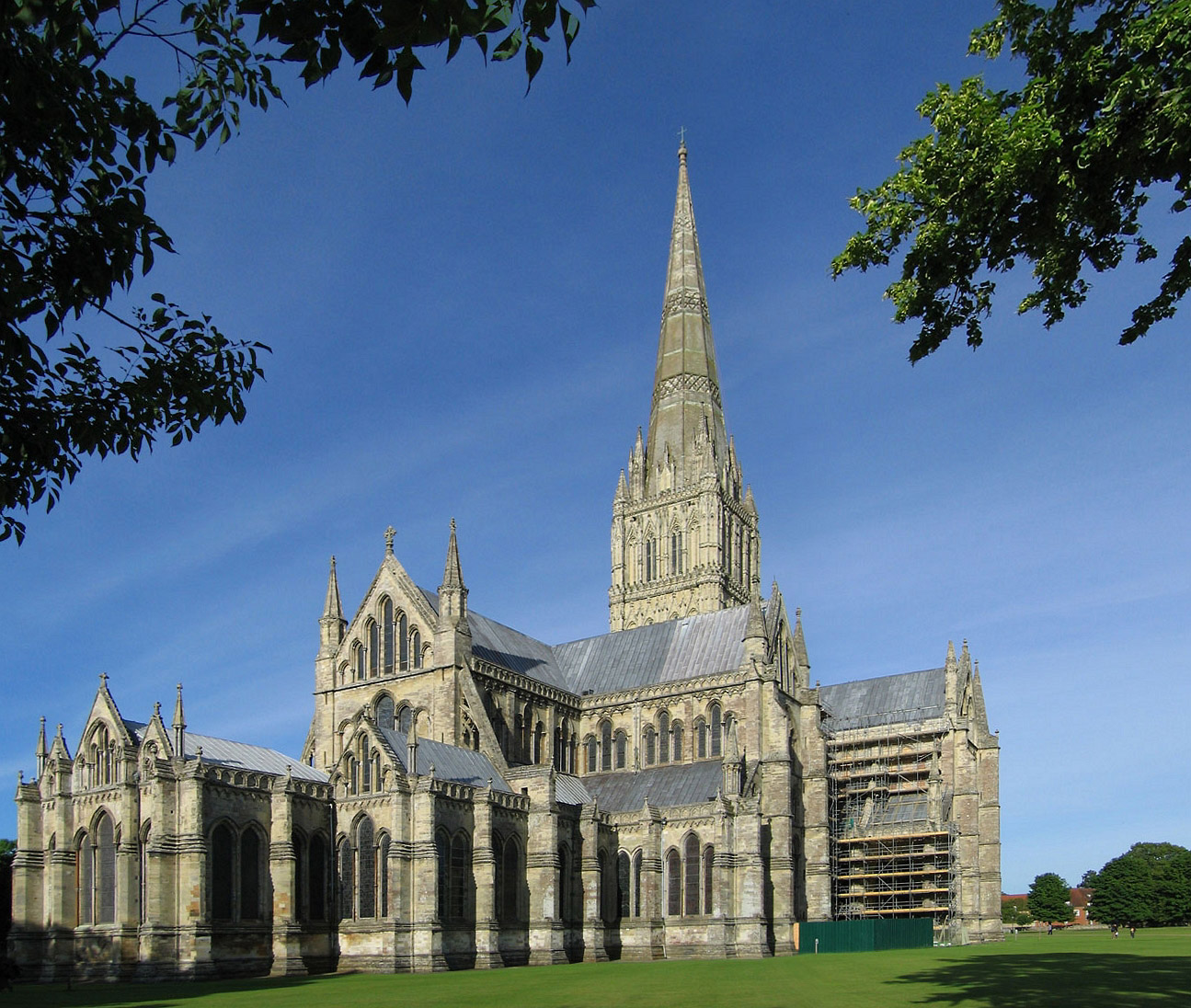The Scala Foundation's mission is to transform American and, hence, Western culture through beauty in education and worship so that we are formed by grace to change society, one personal relationship at a time. To the degree that each of us contributes to this ideal, we will help create a culture of beauty that speaks of the Christian Faith and Western values.
A Video and Recording of New Music For the Mass Composed by Paul Jernberg
The Church and the Sacred Arts - Music
When it comes to the Liturgy, what does the Church actually tell us about the role of music, and why guidelines does the Church give us in selecting music?
Of the three sacred arts of art, architecture, and music, the Church has given us the most explicit direction when it comes to music. But as music acts (or should act) in concert with art and architecture, what is said of one can apply to the others.
Universalis.com Now Has Pointed Psalms - You Can Sing the Office At Home Using Your Smartphone
How to Compose Psalm Tones for the Vernacular - Have a Go Yourself
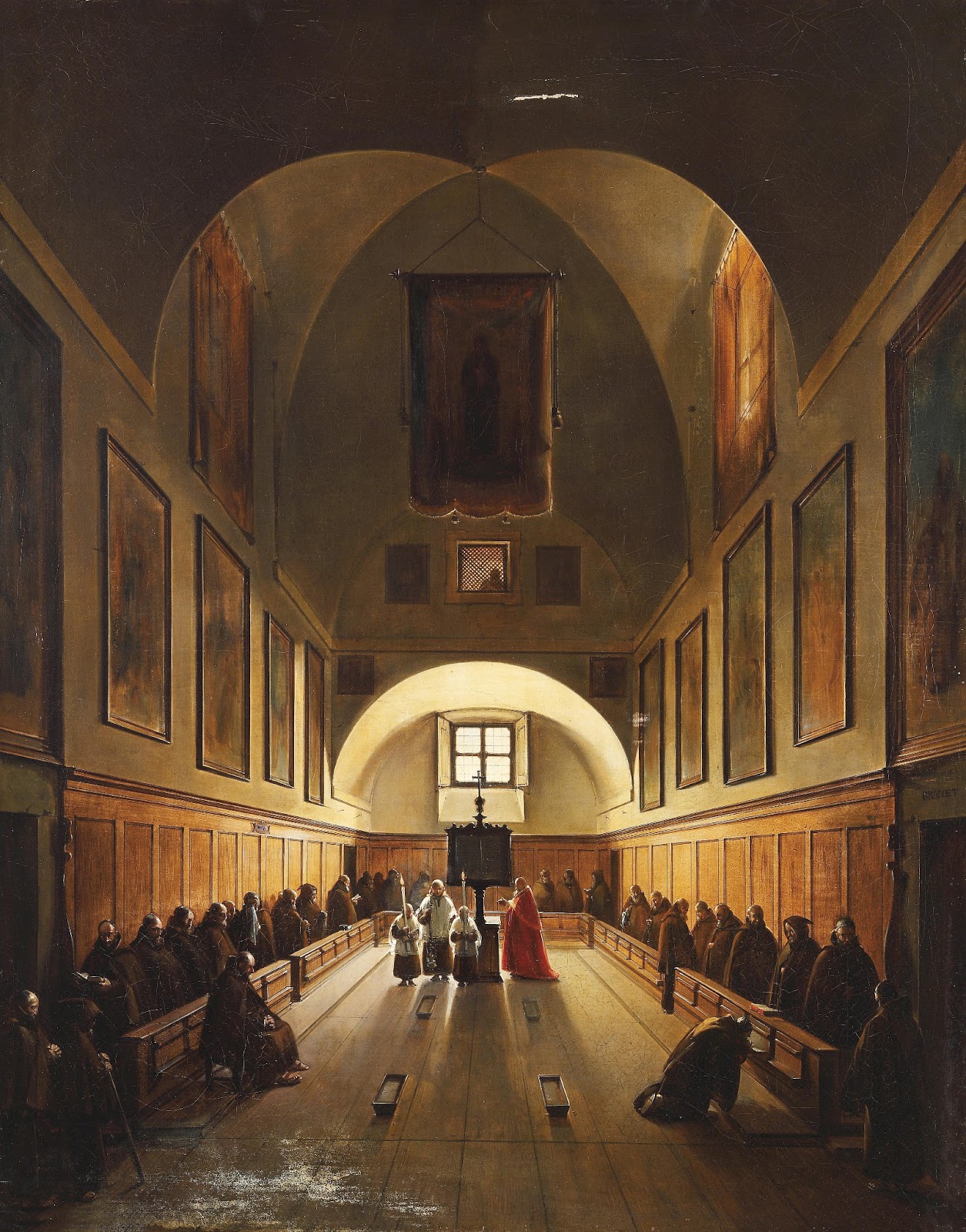 Here's an article that I wrote and was first posted on the traditional music website, Corpus Christi Watershed. It is about the principles used when creating psalm tones for the vernacular. It explains the method by which the tones that are given on this site were developed at Thomas More College and how we tried to incorporate the principles of tradition when adapting tones from the old English Sarum Rite written originally for the Latin to the English. Read the full article here.
I always maintain that to be vital, every tradition must always have new forms that encapsulate its essential elements, but speak anew to each successive generation. This means that we cannot simply look at the past in regard to sacred music. We must also compose. If we don't the tradition will die again. So, in accord with that I say if you don't like what I have done then please think about creating something that you do like!
Here's an article that I wrote and was first posted on the traditional music website, Corpus Christi Watershed. It is about the principles used when creating psalm tones for the vernacular. It explains the method by which the tones that are given on this site were developed at Thomas More College and how we tried to incorporate the principles of tradition when adapting tones from the old English Sarum Rite written originally for the Latin to the English. Read the full article here.
I always maintain that to be vital, every tradition must always have new forms that encapsulate its essential elements, but speak anew to each successive generation. This means that we cannot simply look at the past in regard to sacred music. We must also compose. If we don't the tradition will die again. So, in accord with that I say if you don't like what I have done then please think about creating something that you do like!
The painting, by the way, is from 1808 by the French artist Granet of the choir singing in the Capuchin church in Rome.
The Logos of Sacred Music, by Paul Jernberg
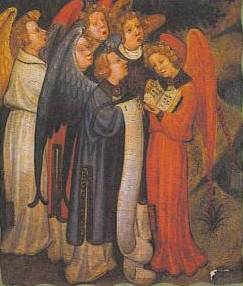 A composer tells us his approach in composing works that are fresh and new, while reflecting the timeless principles that constitute sacred music. Listen also to his beautiful newly composed Mass.
The following is an essay written by the composer Paul Jernberg. Paul has composed his Mass of St Philip Neri for the new translation of the Mass. In the essay below he discusses the principles that guide him in composition and which enable him to compose new music in accordance with timeless principles. We have been singing his compositions at Thomas More College - I have been working with him in creating psalm tones for the vernacular that are modal and so sit within the tradition.This has enabled us to chant, for example, the traditional Latin proper for communion and then a communion meditation in English without any sense of disunity.
A composer tells us his approach in composing works that are fresh and new, while reflecting the timeless principles that constitute sacred music. Listen also to his beautiful newly composed Mass.
The following is an essay written by the composer Paul Jernberg. Paul has composed his Mass of St Philip Neri for the new translation of the Mass. In the essay below he discusses the principles that guide him in composition and which enable him to compose new music in accordance with timeless principles. We have been singing his compositions at Thomas More College - I have been working with him in creating psalm tones for the vernacular that are modal and so sit within the tradition.This has enabled us to chant, for example, the traditional Latin proper for communion and then a communion meditation in English without any sense of disunity.
What characterises both the compositions you can hear here and the music he has composed for us at Thomas More College of Liberal Arts is how simple it is to perform, yet how good it sounds. He really has hit that standard of noble simplicity - music that is so beautiful that you want to sing it, and so simple that you can. Furthermore, there is not even a hint of sentimentality in his music.
I have punctuated the text of his essay with links through to audio of the St Philip Neri Mass so that you can pause and listen as you read along. The attached audio files have been recorded by members of the Parish Choir of St. John's in Clinton, MA and of the Chorus of Trivium School, a Catholic high-school in Lancaster, MA (plus myself and Dr Tom Larson from Thomas More College of Liberal Arts and an additional member of Tom's amateur chant and polyphony choir, the Schuler Singers). Please bear in mind as you listen to them that they are not professional recordings and precisely because it is amateur singers that you are listening to it represents an endeavor to incarnate the ideal articulated in the essay on the Parish level:
The Logos of Sacred Music
An introduction to the Mass of Saint Philip Neri
The composition of this work has been my response to the need for a fitting musical setting of the Ordinary from the new English translation of the Roman Missal. In the creation of this music it has been my goal to fulfill three essential criteria, namely, that it have a true sacred character, that it be imbued with the qualities of authentic artistry, and that it possess a noble accessibility will allow it to be received into the hearts of ordinary people of good will throughout the English-speaking world.
Sacred Character
Music in the Liturgy of the Catholic Church should by its nature have a distinct identity that is contemplative, vibrant, and rooted in ancient tradition. In the perennial Catholic vision of the Liturgy, all of its sensible elements are intended to provide a sacred space that is worthy to welcome the sacramental Divine Presence. This intention would seem to surpass the reasonable scope of ordinary human creativity, as the finite aspires to welcome the infinite, the creature to create a worthy space for the Creator. And yet, both faith and aesthetic sensitivity perceive that an inspired tradition has indeed developed over the course of the centuries – including aspects such as architecture, visual arts, and music - which has fulfilled this task in a marvelous way.
In the West, this inspired musical tradition has as its foundation a vast repertoire commonly known as Gregorian Chant. Any composer who wishes to approach the task of composing music for the Roman Catholic Liturgy in a serious way, should thus be thoroughly versed in the study and performance of this repertoire, realizing the littleness of his own efforts in relation to the greatness of the tradition. The composer should also seek to understand and apply those musical principles of Gregorian Chant that have allowed it to serve its purpose so aptly. As expressed by the authors of the post-conciliar Church document, Musicam Sacram:
Musicians will enter on this new work with the desire to continue that tradition which has furnished the Church, in her divine worship, with a truly abundant heritage. Let them examine the works of the past, their types and characteristics, … so that “new forms may in some way grow organically from forms that already exist,” and the new work will form a new part in the musical heritage of the Church, not unworthy of its past.[1]
And furthermore:
Let them produce compositions which have the qualities proper to genuine sacred music, not confining themselves to works which can be sung only by large choirs, but providing also for the needs of small choirs and for the active participation of the entire assembly of the faithful.[2]
Along these same lines Pope Benedict XVI recently pointed out:
It is possible to modernize holy music, but this cannot happen outside the great traditional path of the past, of Gregorian chants and sacred polyphonic choral music… [3]
What are the “qualities proper to genuine sacred music” that need to be followed attentively in the composition and performance of new works? This is in fact a crucial question which requires much more space than the scope of this introduction would allow, in order to be answered adequately. However, a few first principles can be briefly articulated here:
- The human voice is always the primary instrument, and often the only instrument. Being an integral part of man, rather than his exterior creation, the voice has a unique capacity for intimate expression of the depth and breadth of human feeling and experience. It is equally accessible to all people and all cultures. When the organ or other instruments are used, it is for the purpose of supporting or enhancing, rather than dominating or supplanting, the voice.
- The rhythm of the music is united with the natural rhythm of the given sacred text, either through assuming the textual rhythm as its own, or by engaging in a gentle interplay with it. Any strong metrical or rhythmic effects that might overshadow the meaning of the text are avoided. With a few exceptions, Gregorian chant is characterized by a non-metered rhythm that allows great freedom in respecting the meaning and flow of the Word.
- Melodic lines and harmonies are carefully chosen to evoke dispositions and emotions that are appropriate to liturgical worship and interiority, and which steer clear of secular associations. This distinction is not meant in any way to demean the multifarious beauty that belongs to secular life and art, or to deny its transcendent dimension, but rather is meant to facilitate the flourishing of each - the sacred and the profane[4], divine worship and social intercourse - in its own proper time and place.
Authentic Artistry
It does not do justice to the nature of the Liturgy for its music to be merely correct, even according to the above-mentioned principles. In order for sacred music to reach its full stature, composers and musicians need to exercise true artistry, in which knowledge, inspiration, and skill all play a vital role.
Many may object here, saying that liturgical music is meant for “prayer rather than performance,” implying that prayer, being a humble, intimate communication with God, excludes or minimizes the need for artistry, which by its nature demands a focus on the externals of music-making. There is an element of truth in this, namely, that the relational dimension of the Liturgy is of immeasurably more importance than the artistic dimension. However, it is this very relational dimension which should motivate and empower composers and musicians as they devote all of their skill to create something as beautiful as possible for God, the Beloved. In addition, a certain level of artistry in composition and choral performance provides a foundation from which the other participants in the Liturgy can more fully interiorize the meaning of the words and more prayerfully join in the singing of their parts.
In the context of sacred music, compositional artistry will be manifested in gracefulness and dignity of melodic line, harmony, and dynamics, rather than in striking effects or grandiosity. The artistic performance of this music by cantors and choirs requires, among other things, diligent attention to precision of pitch and rhythm, natural resonance, lively and sensitive dynamics, appropriate tone quality, and clear diction. Qualities such as interiority and unity of sound among voices should preclude any harsh effects or displays of virtuosity, however appropriate these latter might be in other contexts.
Composers and performers of all kinds of music bear witness to the fact that the phenomenon of inspiration is a mysterious but important element in their creative process. How much more should the composer of sacred music, conscious of the dignity of the Liturgy, prayerfully seek that inspiration which will give his music a living, joyful, peaceful identity, beyond the mere notes on the musical score? When this gift is skillfully cultivated, choirs and congregations can in their turn participate in an experience of inspired beauty, which is directed toward the praise and glory of God.
Noble Accessibility
One of the clearest messages from the Second Vatican Council to composers of sacred music, was the need to create music that would facilitate the “full, conscious, and active” participation of the faithful:
In the restoration and promotion of the sacred liturgy, this full and active participation by all the people is the aim to be considered before all else, for it is the primary and indispensable source from which the faithful are to derive the true Christian spirit…[5]
How can music help to achieve this goal, while faithfully maintaining the other foundational qualities listed above? On the one hand, unceasing and genial efforts should be made to help priests and lay people to re-discover the great traditions of sacred music that are in fact their rightful patrimony. Too often this heritage has been ignored or rejected on the false premise that it is no longer relevant to modern man. On the other hand, the legitimate development of culture, as well as the authorized use of the vernacular in the Liturgy, beg for the conception of worthy new music to accompany both Latin and translated Liturgical texts. And in order for this music to fulfill its purpose, it needs to be imbued with a noble accessibility that allows it to be not only admired, but also deeply welcomed by “ordinary” people so as to become a fitting and authentic expression of their faith.
When this quest for full participation has been separated from the need for true sacred character and authentic artistry in liturgical music, as has often been the case over the decades since Vatican II, the results have been deeply disturbing for those sensitive to the musical, psychological and spiritual dimensions of the Mass. As world-renowned maestro Riccardo Muti recently observed:
The history of great music was determined by what the Church did. When I go to church and I hear four strums of a guitar or choruses of senseless, insipid words, I think it's an insult… I can't work out how come once upon a time there were Mozart and Bach and now we have little sing-songs. This is a lack of respect for people's intelligence. [6]
This interview, in which Muti praised the efforts of Pope Benedict to promote a renewal of sacred music, was a tremendous encouragement to me in my composition of the Mass of St. Philip Neri. He speaks authoritatively on behalf of all great musicians and all devout Catholics when he pleads for the renewal of sacred music in the Church’s Liturgy. At the same time he understands the need for accessibility:
Rather than obsess over creating masterpieces, contemporary composers should “prepare the future for a new language in the world of music - not one but several languages - that are more closely connected to the needs of people.” [7]
In searching for compositional models that do integrate sacred character, authentic artistry, and noble accessibility, I have in fact found two wonderful sources of inspiration. The first is the harmonized liturgical chant of the Russian Orthodox Church, developed by composers such as Smolensky, Chesnokov, and Rachmaninoff. The second is the music of Jacques Berthier written for the ecumenical Taizé Community in France, which has brought an elegant simplicity and power to the singing of sacred texts by very large groups of people. In each of these cases, composers with highly sophisticated skills have deliberately set aside the kind of harmonic and rhythmic complexity appropriate to the concert hall, in order to bring intense depth and beauty to simpler forms that thus become nobly accessible to “common” people from a wide variety of backgrounds. Both of these sources have been my constant companions in the composition of this musical setting of the Mass.
St. Philip Neri
I have chosen to name this work in honor of Philip Neri, because his life and apostolate, which effected such a great spiritual and cultural renewal in 16th century Rome, have also been an ongoing inspiration to me and the choirs that I have had the privilege of directing. Through his Oratory movement, which combined prayer, study, works of mercy, joyful fellowship, and the cultivation of the arts, he became a patron to great composers such as Palestrina and Animuccia. Influenced by the contagious holiness and joy of St. Philip, they were able to create a magnificent new repertoire of sacred polyphony, rooted in the ancient tradition of Gregorian chant, but also responding to the new needs and inspirations of their day. My hope and prayer is that the Mass of St. Philip Neri might be one small flame in a similarly authentic renewal of sacred music, faith and culture that is so needed in the Catholic Church today!
Paul Jernberg Clinton, Massachusetts February 24, 2012
You shall sprinkle me, listen here
[1] Musicam Sacram, Art. 59; quote from Sacrosanctum Concilium, Art. 23
[2] Sacrosanctum Concilium, Art. 121
[3] Comments by Pope Benedict during a concert conducted by Dominico Bartolucci, June 24, 2006.
[4] The word ‘profane’ here is used in its first meaning, which is ‘outside the temple’ (Gr. pro - fanus).
[5] Sacrosanctum Concilium, Art. 14
[6] Riccardo Muti interview with ANSA.IT, May 27, 2011
[7] John von Rhein interview with Muti in the Chicago Tribune, January 29, 2012
The Thomas More College approach to Music in the Liturgy
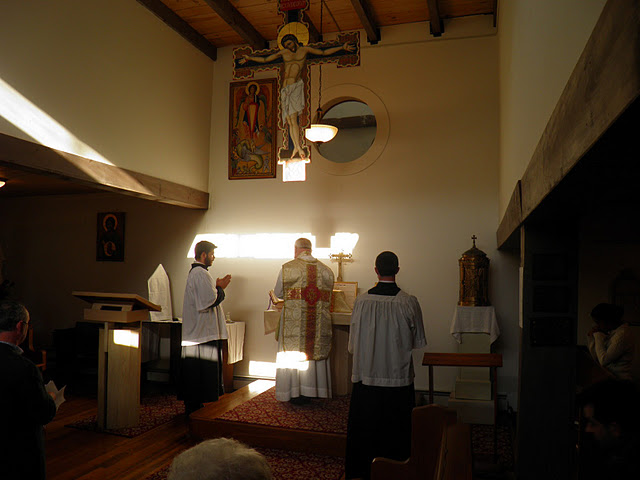 The choir at Thomas More College of Liberal Arts is busy learning a repertoire for the Mass and the Liturgy. The aim is to have a repertoire that is small enough that each piece is heard often enough by those who are not in the choir that they can become familiar and sing along. At the same time it must be large enough that there is some variety in the music.
In regard to the choice of pieces, we have in mind also the principle of noble simplicity. Again this is to facilitate active participation of the laity in the liturgy. Accordingly we try to choose music that that is appropriate, simple and beautiful. We choose predominantly chant and traditional liturgical hymns and polyphony, with the idea in mind that it should be simple enough so that most people can quickly learn to sing it and it is beautiful enought so that they are motivated to do so.
The choir at Thomas More College of Liberal Arts is busy learning a repertoire for the Mass and the Liturgy. The aim is to have a repertoire that is small enough that each piece is heard often enough by those who are not in the choir that they can become familiar and sing along. At the same time it must be large enough that there is some variety in the music.
In regard to the choice of pieces, we have in mind also the principle of noble simplicity. Again this is to facilitate active participation of the laity in the liturgy. Accordingly we try to choose music that that is appropriate, simple and beautiful. We choose predominantly chant and traditional liturgical hymns and polyphony, with the idea in mind that it should be simple enough so that most people can quickly learn to sing it and it is beautiful enought so that they are motivated to do so.
For Latin we choose traditional chant aiming for familiarity with chant Masses for weekdays, Sundays, Marian Feasts and Feastdays and Sundays during Lent and Advent. These are introduced gradually, so that there is a slowly growing core repertoire. We are very lucky to have Dr Tom Larson of the Schuler Singers coming to the college to teach us. He posts audio files of those things that we need to learn so that we can download them. I am now the proud owner of an ipod! So I download these files and sing them as I drive into work every morning. We are a choir learning at the beginning so we are not capable yet of anything beyon simple polyphonic pieces (never mind the rest of the congregation). But for most part, the assumption will be the polyphonic pieces are an invitation to meditation on the part of the congregation. Accordingly the degree of polyphonic content would always be chosen so that the degree of active singing participation is balanced with listenting so as to encourage even on these occasions an engaged contemplation of the liturgy (which is another aspect of active participation in the liturgy of course).
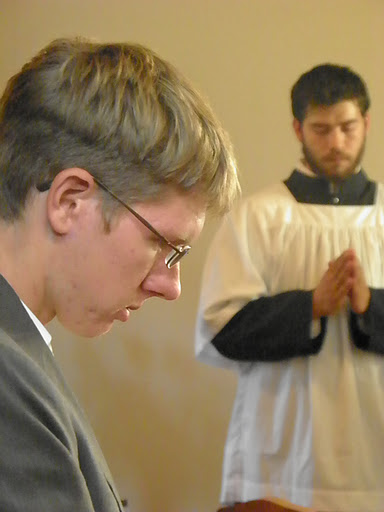 When seeking to get the music in the liturgy going at the college, especially chant in the liturgy of the hours, I took advice on what might be the best way to do it. A useful piece of advice that was given to me by Fr Frank Philips of St John Cantius in Chicago. He suggested that we pitch the singing down so that it is always comfortable for men to sing. He said that the women will be more able (and more inclined!) to sing lower than the men will be able to sing higher. This was important to me, because I wanted the males students to develop the habit of singing their prayers without being self-conscious about it.
When seeking to get the music in the liturgy going at the college, especially chant in the liturgy of the hours, I took advice on what might be the best way to do it. A useful piece of advice that was given to me by Fr Frank Philips of St John Cantius in Chicago. He suggested that we pitch the singing down so that it is always comfortable for men to sing. He said that the women will be more able (and more inclined!) to sing lower than the men will be able to sing higher. This was important to me, because I wanted the males students to develop the habit of singing their prayers without being self-conscious about it.
The hope in engaging the men in the college is to re-establish the idea that prayer is a masculine thing and so promote the idea that fathers can lead the family in prayer; and perhaps also encourage vocations to the priesthood. The audio files that Tom posts for us are pitched lower than many other chant resources I have come across and so are comfortable for most amateur male voices. This has encouraged a more vigourous masculine sound to the chant. Wherever possible we sing antiphonally, separating men and women. This allows each voice to flourish separately in a complementary rather than a competitive way.
For variation we sing some of the Propers and Latin hymns with an 'organum' - a very simple but beautiful harmony. If you listen to this version of Stabat Mater, you hear occasionally a simple harmony behind the chant. It always strikes me that is mimicking the echo that is there if you sing in a church that is built acoustically for chant, such as a gothic abbey. I am an oblate of Pluscarden Abbey in Scotland, which is a medieval building. When I am there the harmonising echo that resonates, complements the singing and always suggests to me the voices of the angels and saints in the heavenly liturgy which we know, objectively, are singing with us.
http://www.youtube.com/watch?v=muJccdJJrwk
The occasional use of organum opens the imagination of the listeners to the implied harmonies that are present in the intervals of pure chant.
For the vernacular we look to the traditions of harmonised Anglican chant and also Eastern tones. Latin emphasises syllables in a very different way to English. Consequently, plainchant, which was developed over centuries to suit the rhythms and patterns of the Latin language is difficult to adapt to English. The Anglicans had a centuries old tradition of doing this and from it has developed a distinct tradition. I have interpreted Pope Benedict XVI's creation of the Anglican Ordinariate and his attendance at Choral Evensong when he visited last year as a sign that we have been encouraged to look at it as a resource for the vernacular. in the link below you can hear an Anglican adaptation of the Latin tonus peregrinus (which is itself an adaptation of a tone from the pre-Christian Jewish liturgy). While the harmonisation will require a choir, all the students are taught to sing the basic melody and they pick this up very quickly indeed.
http://www.youtube.com/watch?v=9f4_IhaSnVw
Because the Greek and Slavic languages have a punchier rhythms and stresses on the consonants, the music of the Eastern liturgy has, it seems to me, been adapted to English much more successfully. We have been using some of the harmonised tones in our own liturgy too.
http://www.youtube.com/watch?v=WkqZbFQb0O0&feature=related
We have found that when these are rooted in the rhythm of speech and musically are in modal form, it is possible, with careful choice, to have a unified feel to the music of the liturgy while relying on these different sources.
Much of what we do is adapted to make it simple for many to join in. I hope gradually (assuming I can cope with the technology) to start posting examples of our choir singing these adaptations.
Readers may also like to know that the Schuler Singers are singing at the installation of the new Bishop of New Hampshire, Most Reverend Peter A. Libasci on December 8th, 2pm at St Joseph's Cathedral in Manchester, New Hampshire.
Concert of Music from the Sarum Rite
This is sacred music from pre-Reformation England. Sarum is old name for the town of Salisbury and it disappeared as a form of the Church's liturgy after the Council of Trent. However, it was retained in some form as it became the basis of Anglican church music and for the Book of Common Prayer. The concert takes place in a New York Episcopalian church - Trinity Church. I heard about it because it was posted onto my Facebook page by a TMC student who is currently out in Rome - thanks Taylor! Access the video through the image of Salisbury Cathedral below.







